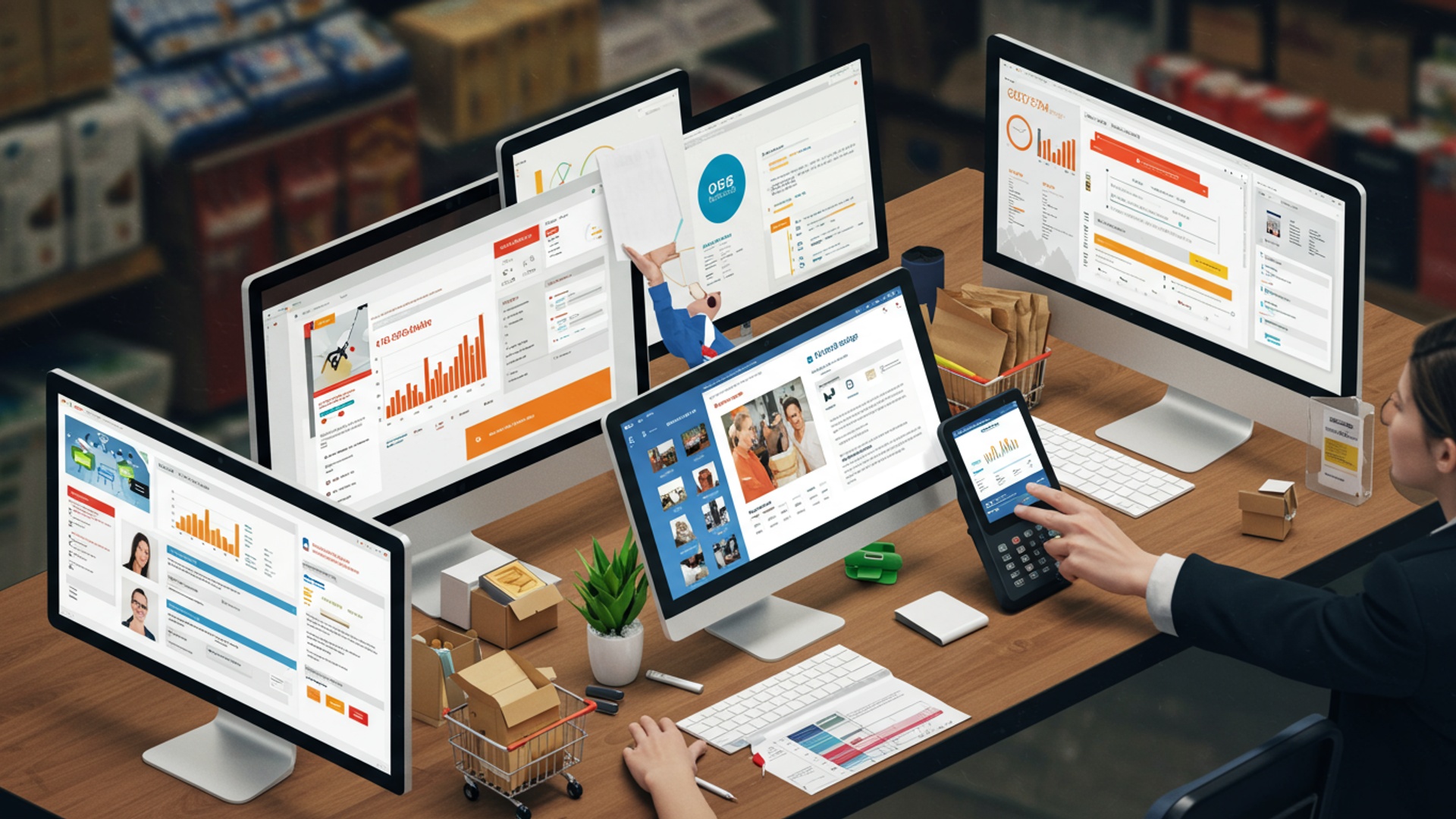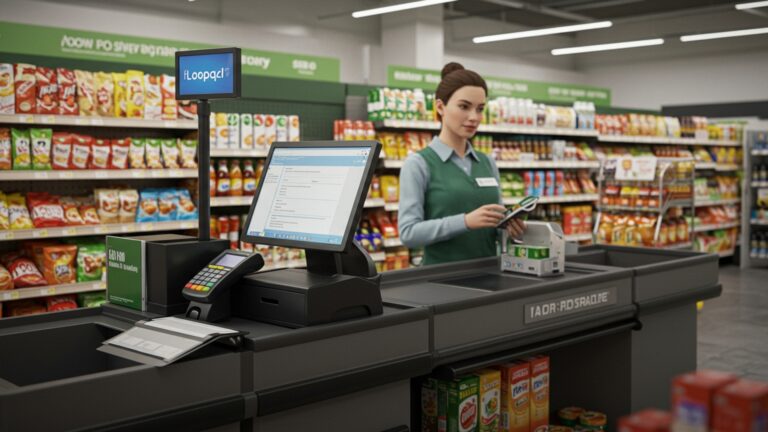A Complete Guide to Choosing the Best POS Software for Retail
In today’s dynamic retail landscape, a robust POS software transcends mere transaction processing, evolving into the central nervous system for modern businesses. Retailers now demand sophisticated systems capable of unifying inventory across brick-and-mortar and e-commerce channels, facilitating frictionless omnichannel experiences. powering advanced analytics for personalized customer engagement. With the rapid adoption of contactless payments and the imperative for real-time data insights, choosing the right POS is no longer a peripheral decision but a strategic investment directly impacting operational efficiency, customer loyalty. ultimately, profitability. The market offers a diverse array of cloud-based solutions, each promising scalability and integration, yet discerning the optimal fit requires a deep understanding of evolving retail demands and future-proof capabilities.

Understanding the Core: What is POS Software?
In the dynamic world of retail, the term “POS” is frequently encountered. what exactly does it entail? POS stands for Point of Sale. at its heart, a POS system is where your customer makes a payment for products or services. Historically, this meant a simple cash register. Today, But, modern pos software has transformed this basic transaction into a powerful, multifaceted operational hub for retailers, acting as the central nervous system of their business.
A modern POS system is typically comprised of two main components:
- Hardware
- Software
This includes physical devices such as a register screen (tablet or desktop monitor), barcode scanner, credit card reader, receipt printer. cash drawer.
This is the brain of the operation, the program that runs on the hardware. It processes transactions, manages inventory, tracks sales data. often integrates with other business tools. This is the crucial element we’ll be focusing on.
- pos software
- pos software
Why Your Retail Business Needs Modern POS Software
- pos software
- pos software
- Enhanced Efficiency
- Superior Inventory Management
- In-depth Sales Reporting and Analytics
- Improved Customer Relationship Management (CRM)
- Streamlined Employee Management
- Robust Security
- Scalability
Automates routine tasks like inventory updates, sales calculations. receipt generation, saving valuable time and reducing human error.
Provides real-time tracking of stock levels, automates reordering, identifies fast-moving and slow-moving items. helps prevent stockouts or overstocking. This leads to better cash flow and reduced waste.
Generates comprehensive reports on sales trends, peak hours, popular products. employee performance. These insights are invaluable for making informed business decisions, from marketing strategies to staffing schedules.
Many pos software solutions can store customer purchase history, contact data. preferences, enabling personalized marketing efforts, loyalty programs. a more tailored shopping experience.
Track employee hours, manage commissions, assign roles. monitor individual sales performance, improving accountability and operational flow.
Modern systems come with features like PCI compliance, data encryption. user access controls, protecting sensitive customer data and preventing internal theft.
As your business grows, the right pos software can grow with you, easily accommodating new products, locations, or sales channels without requiring a complete system overhaul.
- pos software
- pos software
Key Features to Look for in Retail POS Software
When selecting pos software, it’s crucial to identify the features that align with your specific retail needs. Not all systems are created equal. a comprehensive solution will offer a blend of core functionalities and advanced capabilities. Here’s a breakdown of essential features:
- Sales & Transaction Processing
- Multi-Payment Options
- Returns, Exchanges. Store Credit
- Discounts, Promotions. Bundling
- Offline Mode
- Inventory Management
- Real-time Tracking
- Automatic Reordering
- Product Variants
- Barcode Scanning
- Vendor Management
- Customer Relationship Management (CRM)
- Customer Profiles
- Loyalty Programs
- Targeted Marketing
- Reporting & Analytics
- Sales Reports
- Product Performance
- Employee Performance
- Inventory Reports
- Customizable Dashboards
- Employee Management
- Time Clock Functionality
- Role-Based Permissions
- Commissions Tracking
- Multi-Store Management (if applicable)
- Centralized Inventory
- Unified Reporting
- Employee Transfers
- Integrations
- E-commerce Platforms
- Accounting Software
- Marketing Tools
- Payment Processors
- Hardware Compatibility
- Security Features
- Mobile POS Capabilities
Accept credit/debit cards, mobile payments (Apple Pay, Google Pay), gift cards. cash.
Handle these smoothly with clear audit trails.
Easily apply various offers and create product bundles.
Process transactions even when the internet connection is down, syncing data later.
Know exactly what you have in stock across all locations.
Set reorder points to prevent stockouts.
Manage different sizes, colors. styles of the same product.
Speed up checkout and inventory counts.
Track supplier insights and purchase orders.
Store contact insights, purchase history. preferences.
Implement points-based systems, discounts, or special offers for repeat customers.
Use customer data to send personalized promotions.
Daily, weekly, monthly. yearly sales data.
Identify best-sellers and underperforming items.
Track individual sales and productivity.
Stock levels, costs. turnover rates.
Visualize key metrics at a glance.
Track employee clock-ins and outs.
Control access to sensitive data and functions.
Calculate sales commissions accurately.
Manage stock across multiple retail locations from one dashboard.
Get consolidated sales and performance data for all stores.
Easily manage staff across different branches.
Sync online and in-store sales and inventory (e. g. , Shopify, WooCommerce).
Seamlessly transfer sales data to QuickBooks, Xero, etc.
Connect with email marketing or CRM platforms.
Compatibility with preferred payment gateways.
Ensure the pos software works with existing or easily obtainable hardware.
PCI DSS compliance, data encryption, user authentication.
Use tablets or smartphones for sales on the go, pop-up shops, or queue busting.
On-Premise vs. Cloud-Based POS Software: A Crucial Choice
One of the most fundamental decisions you’ll face when choosing pos software is whether to opt for an on-premise or cloud-based solution. Each has distinct advantages and disadvantages, impacting everything from cost and maintenance to accessibility and data security.
This type of system is installed directly on your local computers and servers within your retail location. You own the software license and are responsible for its maintenance, updates. data storage.
Also known as web-based or online POS, this system operates over the internet. The software and your data are hosted on the provider’s remote servers. you access it via a web browser or app on any internet-connected device. You typically pay a recurring subscription fee.
| Feature | On-Premise POS Software | Cloud-Based POS Software |
|---|---|---|
| Cost Structure | High upfront cost (software license, hardware, installation) with lower recurring fees (maintenance, updates). | Lower upfront cost (subscription fees, hardware purchase/lease) with ongoing monthly/annual subscription fees. |
| Data Storage | Data stored locally on your servers. Full control over your data. | Data stored on the provider’s remote servers. Access via internet. |
| Accessibility | Limited to your physical location unless remote access is configured. | Access from anywhere with an internet connection (mobile devices, laptops). |
| Maintenance & Updates | Your responsibility (IT staff, external support). Can be complex and costly. | Managed by the provider. Automatic updates and bug fixes. |
| Security | Your responsibility to implement and maintain security measures. Potentially higher risk if not managed properly. | Provider is responsible for server security, backups. encryption. Generally robust. |
| Scalability | Requires additional hardware and licensing for expansion, potentially complex. | Easily scalable by adjusting subscription plans, adding users/locations. |
| Internet Dependency | Can operate offline without internet (though some features might be limited). | Requires internet connection for full functionality (many offer offline mode for transactions). |
| Customization | Often allows for deeper customization. requires technical expertise. | Customization options are usually limited to what the provider offers. |
- pos software
- pos software
Evaluating POS Software Providers: What to Consider Beyond Features
While features are critical, the functionality of the pos software itself is only one piece of the puzzle. The provider behind the software, their support. their business model are equally essential. A thorough evaluation requires looking at several key aspects:
- Cost Structure
- Initial Costs
- Recurring Costs
- Hidden Costs
- Scalability
- Ease of Use & User Interface (UI/UX)
- Customer Support & Training
- Availability
- Channels
- Quality
- Reputation & Reviews
- Security & Compliance
- Data Migration
Software licenses, setup fees, hardware purchases.
Monthly/annual subscription fees, payment processing rates, maintenance contracts, update fees.
Be wary of additional fees for specific integrations, advanced reports, or premium support. Always ask for a detailed breakdown.
Can the pos software grow with your business? If you plan to open more locations, add more products, or expand into e-commerce, ensure the system can accommodate these changes without a complete overhaul.
A complex system will lead to errors, slow down transactions. frustrate staff. Look for intuitive interfaces, clear navigation. minimal training requirements. A good UI/UX is paramount for efficient daily operations.
Is support available 24/7, during business hours, or via a ticketing system?
Phone, email, live chat, knowledge base.
Read reviews about their support responsiveness and effectiveness. Ask about initial setup assistance and ongoing training resources.
Research the provider’s track record. Look at independent review sites (e. g. , Capterra, G2, Software Advice), industry forums. testimonials. Pay attention to common complaints or praises regarding reliability, support. feature delivery. Credible sources like industry publications or technology review sites can offer unbiased insights.
Verify the provider’s adherence to industry standards like PCI DSS (Payment Card Industry Data Security Standard) for handling credit card insights. interpret their data backup protocols and how they protect your business and customer data from breaches.
If you’re switching from an existing system, how easy is it to migrate your existing product data, customer lists. sales history? Some providers offer migration services, while others provide tools for self-migration. This can be a significant undertaking if not planned properly.
For example, “Books & Brews,” a popular café and bookstore, decided to switch their pos software. While reviewing options, they prioritized a system with excellent 24/7 customer support, as their business operated extended hours. They learned from a peer’s negative experience with a provider whose support was only available during standard business hours, leading to critical downtime during peak times. This anecdote highlights that support can be as crucial as features.
Implementation and Training: Making the Transition Smooth
Once you’ve chosen the best pos software for your retail business, the next critical phase is implementation. A well-executed rollout and thorough staff training are essential to ensure a smooth transition and maximize your return on investment. Rushing this stage can lead to frustrating downtime, employee resistance. operational bottlenecks.
- Strategic Planning for Rollout
- Phase-in Approach
- Timing
- Data Preparation
- Data Migration Best Practices
- Backup Everything
- Test Data Sets
- Validate Data
- Professional Assistance
- Comprehensive Staff Training Strategies
- Hands-on Sessions
- Training Materials
- Role-Playing & Scenarios
- Designated Super Users
- Ongoing Support
- Testing and Going Live
- System Testing
- Pilot Run
- Post-Launch Monitoring
- Assess Your Current Needs and Pain Points
- What specific problems are you trying to solve with new pos software (e. g. , slow checkout, inaccurate inventory, lack of customer data)?
- What are your current operational bottlenecks?
- What unique requirements does your retail niche have (e. g. , consignment, serialized items, complex pricing)?
- Define Your Budget
- Determine your comfortable range for upfront costs (hardware, setup) and ongoing monthly/annual fees.
- Factor in potential costs for training, integrations. premium support.
- List Essential and Desirable Features
- Based on your needs, categorize features into “must-haves” (e. g. , inventory management, payment processing) and “nice-to-haves” (e. g. , advanced CRM, multi-store capabilities).
- Prioritize features that will have the biggest impact on your efficiency and profitability.
- Research Top Contenders
- Identify leading pos software providers in the retail sector (e. g. , Square, Shopify POS, Lightspeed, Clover, Toast for restaurants, etc. – remember to research based on your specific retail vertical).
- Read reviews on credible software review sites (Capterra, G2, Software Advice) and industry publications.
- Request Demos and Free Trials
- Don’t commit without seeing the pos software in action. Schedule personalized demos that address your specific business needs.
- If available, take advantage of free trials to test the system with your actual products and processes. Get your team involved during the trial period.
- Check Customer References
- Ask providers for references from businesses similar to yours.
- Contact these references to inquire about their experience with the pos software, customer support. overall satisfaction.
- Evaluate Integration Capabilities
- Confirm compatibility with your existing accounting software (e. g. , QuickBooks, Xero), e-commerce platform. other essential tools.
- grasp if integrations are native, require third-party apps, or involve custom development.
- grasp Support and Training Offerings
- Clarify the level of customer support included (24/7, phone, chat, email).
- Inquire about initial setup assistance, training resources. ongoing educational materials.
- Negotiate Contracts and interpret Terms
- Review the contract carefully, paying attention to payment terms, contract length, cancellation policies. any potential hidden fees.
- Don’t hesitate to negotiate pricing or request additional services.
- Plan for Implementation and Training
- Develop a clear implementation timeline and training schedule for your staff.
- Ensure you have the resources (time, personnel) allocated for a smooth rollout.
Consider a phased rollout if possible, perhaps starting with a pilot store or a specific set of functionalities before full deployment.
Schedule the implementation during off-peak hours or slower business periods to minimize disruption.
Clean and organize your existing product data, customer lists. vendor details. Accurate data entry is paramount for the new system’s effectiveness.
Before migrating, ensure all your current data is securely backed up.
If possible, perform a test migration with a small subset of your data to identify any compatibility issues or errors.
After migration, meticulously check the accuracy of your imported data. Verify product counts, pricing, customer details. historical sales.
If your data is complex or extensive, consider utilizing professional data migration services offered by your pos software provider or a third-party expert.
Provide practical, hands-on training sessions for all staff who will interact with the pos software. Focus on their specific roles (cashiers, inventory managers, store managers).
Develop clear, concise user manuals, quick reference guides. FAQs. Some providers offer excellent online tutorials and knowledge bases.
Simulate common transactions, returns, discounts. inventory checks. This builds confidence and familiarizes staff with potential issues.
Train a few key employees to become “super users” or internal experts who can assist colleagues and troubleshoot minor issues post-implementation.
Establish a clear channel for staff to ask questions and report issues during the initial weeks after launch. Regular check-ins and refresher training may be beneficial.
Thoroughly test all hardware components and software functionalities before going live. Ensure barcode scanners, card readers, printers. cash drawers are working seamlessly with the pos software.
If a full pilot store isn’t feasible, consider a short “soft launch” period where the new system runs alongside the old, allowing for comparison and quick problem-solving.
Closely monitor system performance and gather feedback from staff and customers during the initial weeks. Be prepared to address issues promptly.
A sports equipment retailer, “Active Gear Co. ,” successfully implemented new pos software by dedicating a full week to staff training before the official launch. They created a mock store environment where employees practiced every conceivable transaction, from complex returns to applying loyalty points. This proactive approach significantly reduced errors and stress during the actual launch, proving the value of thorough preparation.
Actionable Steps: Your Checklist for Choosing the Best POS Software
Navigating the vast landscape of pos software options can be daunting. with a structured approach, you can confidently select a system that truly empowers your retail business. Here’s an actionable checklist to guide your decision-making process:
Conclusion
As you’ve navigated this comprehensive guide, remember that selecting the best POS software for your retail business isn’t merely a transaction; it’s a strategic investment in your future. Don’t simply chase the latest features; instead, prioritize solutions that genuinely streamline your unique workflows, from managing omnichannel sales to providing real-time inventory insights. I’ve personally observed how a system capable of integrating online orders with physical store stock, a crucial current trend, can prevent stockouts and significantly enhance customer satisfaction, turning a potential hurdle into a competitive advantage. My actionable tip: conduct small-scale pilot programs with your top two choices. Observe how each system performs during peak hours, handles returns. generates the reports vital for your decision-making. This hands-on experience is invaluable, far surpassing any feature list. Ultimately, your POS should be an intuitive partner, not a complex tool. Choose wisely, focusing on scalability and robust support. you’ll unlock efficiencies that boost profitability and empower your team. Embrace this opportunity to modernize. watch your retail venture thrive in an increasingly dynamic market. For further insights into optimizing specific functions, consider boosting your retail profits by optimizing inventory with POS software.
More Articles
How to Optimize Your Billing Process Using Modern POS Software Solutions
7 Essential Tips to Prevent Billing Errors and Save Your Business Money
A Practical Guide to Mastering Business Operations with POS Software
How to Choose the Best POS Software for Your Grocery Store Business
FAQs
What exactly is POS software and why is it so vital for my retail store?
POS (Point of Sale) software is the system your business uses to process customer transactions. Beyond just ringing up sales, it’s crucial because it helps manage inventory, track sales data, process payments efficiently. often includes features for customer management, making your operations smoother and more insightful.
What are the absolute must-have features I should look for in a retail POS system?
Definitely prioritize robust sales processing, comprehensive inventory management, secure payment processing (including various methods), customer relationship management (CRM) tools. detailed reporting and analytics. Ease of use and good technical support are also super crucial.
How much should I expect to pay for good retail POS software?
The cost varies quite a bit depending on the features, number of users. hardware needed. You might find subscription models ranging from $50 to $200+ per month, plus potential upfront costs for hardware or setup. Always consider the total cost of ownership, not just the monthly fee.
Is it a pain to switch to a new POS system, especially if I’m not tech-savvy?
While there’s always a learning curve with new technology, many modern POS systems are designed to be user-friendly with intuitive interfaces. Look for providers that offer good training, clear setup guides. strong customer support to make the transition as smooth as possible.
Can POS software help me keep better track of my inventory?
Absolutely! One of the biggest benefits of a good retail POS system is its inventory management capabilities. It can track stock levels in real-time, alert you when items are low, help with reordering. even manage product variations like size and color, significantly reducing manual errors and stockouts.
What’s the difference between cloud-based and on-premise POS. which one is better?
Cloud-based POS runs on the internet, meaning you can access your data from anywhere, updates are automatic. it usually involves a monthly subscription. On-premise software is installed directly on your computers, giving you more control but requiring you to manage updates and backups. Cloud is generally more flexible and cost-effective for most modern retailers.
Can a POS system help me build customer loyalty or run promotions?
Yes, many advanced POS systems include built-in CRM features that let you track customer purchase history, offer loyalty programs, manage gift cards. even segment customers for targeted marketing campaigns. This can be a huge asset for building repeat business and increasing customer engagement.






